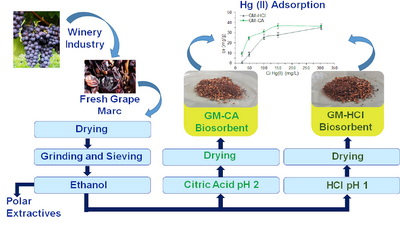GREEN GRAPE MARC BIOSORBENTS PREPARATION FOR MERCURY REMOVAL IN AQUEOUS MEDIA
Scientific paper
DOI:
https://doi.org/10.2298/CICEQ201014008SKeywords:
adsorption isotherms, citric acid, Hg(II) removal, green waste biosorbent, kinetic study, grape marcAbstract
In this study, grape marc waste from Negroamaro (a South of Italy vine variety) winery production was used to prepare biosorbents for Hg(II) removal in aqueous media. A green approach was used to develop a proper biosorbent through two different grape marc washing procedures. In particular, the common chloridric acid and the greener citric acid were evaluated. The biosorbent prepared using citric acid as a washing agent (GM-CA) gave similar results to the biosorbent washed with HCl (GM-HCl) with a maximum adsorption capacity of 36.39 mg g-1. Isothermal studies revealed heterogeneous physical adsorption of Hg(II) on the biosorbents. Moreover, FTIR analysis of the grape marc-based biosorbent without and with Hg(II) confirmed ionic interactions in the biosorbent that fit with a pseudo-second-order kinetic model. Furthermore, no significant adsorption on the biosorbent was observed when two other heavy metals, copper(II) and nickel(II), previously studied for similar sorbents, were considered. Finally, the reusability of GM-CA biosorbent was also demonstrated over three cycles. Thus, the green preparation approach used in this work can be considered suitable for developing grape marc-based biosorbents.
References
WHO, Inorganic mercury - environmental health criteria 118. World Health Organization, International Programme on Chemical Safety, Geneva, Switzerland, 1991. https://apps.who.int/iris/bitstream/handle/10665/40626/IPCS_EHC_118.pdf?sequence=1
J.G. Wiener, D.P. Krabbenhoft, G.H. Heinz, A.M. Scheuhammer, Ecotoxicology of mercury. In: Handbook of Ecotoxicology, Hoffman D. J., Rattner B. A., Burton G. A., Cairns J. (Eds), 2nd Ed., Lewis Publishers, Boca Raton (2003), pp 409—463. https://doi.org/10.1201/9781420032505.ch16
B. Fernandes Azevedo, L. Barros Furieri, F.M. Peçanha, G. A. Wiggers, P. Frizera Vassallo, M. Ronacher Simões, J. Fiorim, P. Rossi de Batista, M. Fioresi, L. Rossoni, L. Stefanon, M.J. Alonso, M. Salaices, D. Valentim Vassallo, J. Biomed. Biotechnol. 2012 (2012) 949048. https://doi.org/10.1155/2012/949048
D.M. Manohar, K.A. Krishnan, T.S. Anirudhan, Water Res. 36 (2002) 1609—1619. https://doi.org/10.1016/S0043-1354(01)00362-1
X. Lu, X. Huangfu, J. Ma, J. Hazard. Mater. 280 (2014) 71—78. https://doi.org/10.1016/j.jhazmat.2014.07.056
M.A. Didi, B. Medjahed, W. Benaoudam, Am. J. Anal. Chem. (2013) 40—47. https://doi.org/10.4236/ajac.2013.47A006
L. Mergola, S. Scorrano, E. Bloise, M.P. Di Bello, M. Catalano, G. Vasapollo, R. Del Sole, Polym. J. 48 (2016) 73—79. https://doi.org/10.1038/pj.2015.79
M.W. Franco, L.A. Mendes, C.C Windmöller., K.A.F Moura., L.A.G. Oliveira, F.A.R. Barbosa, Water Air Soil Pollut. 229 (2018) 127. https://doi.org/10.1007/s11270-018-3782-5
A. Bhatnagar, M. Sillanpää, A. Witek-Krowiak, Chem. Eng. J., 270 (2015) 244—271. https://doi.org/10.1016/j.cej.2015.01.135
M. Erhayem, F. Al-Tohami, R. Mohamed, K. Ahmida, Am. J. Anal. Chem. 6 (2015) 1—10. https://doi.org/10.4236/ajac.2015.61001
F.E. Arias Arias, A. Beneduci, F. Chidichimo, E. Furia, S. Straface, Chemosphere. 180 (2017) 11—23. https://doi.org/10.1016/j.chemosphere.2017.03.137
N.M. Mora Alvarez, J.M. Pastrana, Y. Lagos, J.J. Lozada, Sustain. Chem. Pharm. 10 (2018) 60—70. https://doi.org/10.1016/j.scp.2018.09.004
J. Aurand,2018 OIV statistical report on world vitiviniculture 2018 world vitiviniculture situation. http://www.oiv.int/public/medias/6371/oiv-statistical-report-on-world-vitiviniculture-2018.pdf (accessed 3 March 2020).
M. A. Bustamante, R. Moral, C. Paredes, A. Pérez-Espinosa, J. Moreno-Caselles, M.D. Pérez-Murcia, Waste Manag. 28 (2008) 372—380. https://doi.org/10.1016/j.wasman.2007.01.013
R.A. Mulhack, R. Potumarthi, D.W. Jeffery, Waste Manag. 72 (2018) 99—118. https://doi.org/10.1016/j.wasman.2017.11.011
M.S Rodríguez-Cruz., E. Herrero-Hernández, J.M. Ordax, J.M. Marín-Benito, K. Draoui, M.J. Sánchez-Martín, Int. J. Environ. Anal. Chem. 92 (2012) 933—948. https://doi.org/10.1080/03067319.2011.609933
R. Portinho, O. Zanella, L.A. Féris, Grape stalk application for caffeine removal through adsorption. J. Environ. Manage. 202 (2017) 178—187. https://doi.org/10.1016/j.jenvman.2017.07.033
V. Grudić, J. Šćepanović, I. Bošković, 2015 Chem. Ind. Chem. Eng. Q. 21(2015) 285—293. https://doi.org/10.2298/CICEQ140418027G
I. Villaescusa, N. Fiol, M. Martínez, N. Miralles, J. Poch, J. Serarols, Water Res. 38 (2004) 992—1002. https://doi.org/10.1016/j.watres.2003.10.040
C. Liu, D. Pujol, N. Fiol, M.À. Olivella, F. de la Torre, J. Poch, I. Villaescusa, Water Air Soil Pollut. 226 (2015) 2006. https://doi.org/10.1007/s11270-014-2006-x
R. Chand, K. Narimura, H. Kawakita, K. Ohto, T. Watari, K. Inoue, J. Hazard. Mater. 163 (2009) 245—2502. https://doi.org/10.1016/j.jhazmat.2008.06.084
A.O. Dada, A.P. Olalekan, A.M. Olatunya, O. Dada, IOSR-JAC. 3 (2012) 38—45. https://doi.org/10.9790%2F5736-0313845
M.P. Di Bello, L. Mergola, S. Scorrano, R. Del Sole, Polym. Int. 66 (2017) 1055—1063. https://doi.org/10.3390/ma10101133
V.B.H. Dang, H.D. Doan, T. Dang-Vu, A. Lohi, Bioresour. Technol. 100 (2009) 211—219. https://doi.org/10.1016/j.biortech.2008.05.031
F. Lionetto, R. Del Sole, D. Cannoletta, G. Vasapollo, A. Maffezzoli, Materials 5 (2012) 1910—1922. https://doi.org/10.3390/ma5101910
S. Zmora-Nahuma, Y. Hadarb, Y. Soil Biol Biochem, 39 (2007) 1263—1276. https://doi.org/10.1016/j.soilbio.2006.12.017
N. Naowanat, N. Thouchprasitchai, S. Pongstabodee, J. Environ. Manage. 169 (2016) 103—115. https://doi.org/10.1016/j.jenvman.2015.12.024

Downloads
Published
Issue
Section
License

This work is licensed under a Creative Commons Attribution-NonCommercial-NoDerivatives 4.0 International License.
Authors who publish with this journal agree to the following terms:
Authors retain copyright and grant the journal right of first publication with the work simultaneously licensed under a Creative Commons Attribution License that allows others to share the work with an acknowledgement of the work's authorship and initial publication in this journal.
Authors grant to the Publisher the following rights to the manuscript, including any supplemental material, and any parts, extracts or elements thereof:
- the right to reproduce and distribute the Manuscript in printed form, including print-on-demand;
- the right to produce prepublications, reprints, and special editions of the Manuscript;
- the right to translate the Manuscript into other languages;
- the right to reproduce the Manuscript using photomechanical or similar means including, but not limited to photocopy, and the right to distribute these reproductions;
- the right to reproduce and distribute the Manuscript electronically or optically on any and all data carriers or storage media – especially in machine readable/digitalized form on data carriers such as hard drive, CD-Rom, DVD, Blu-ray Disc (BD), Mini-Disk, data tape – and the right to reproduce and distribute the Article via these data carriers;
- the right to store the Manuscript in databases, including online databases, and the right of transmission of the Manuscript in all technical systems and modes;
- the right to make the Manuscript available to the public or to closed user groups on individual demand, for use on monitors or other readers (including e-books), and in printable form for the user, either via the internet, other online services, or via internal or external networks.





